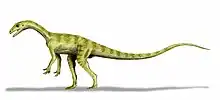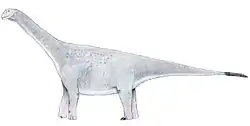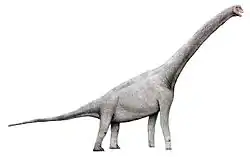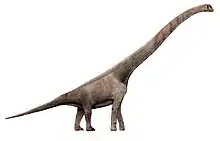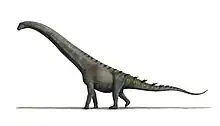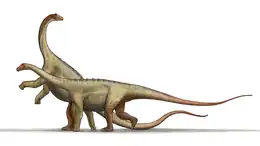Dzharatitanis
Dzharatitanis (meaning "Dzharakuduk titan") is a genus of sauropod from the Bissekty Formation in Uzbekistan, dating to the Turonian age of the Late Cretaceous. The genus contains a single species, Dzharatitanis kingi, named after geologist Christopher King, who contributed to the Cretaceous geology of Asia. It is currently one of two known sauropods from the Bissekty Formation, alongside an indeterminate titanosaur.[1] In its original publication it was considered to be a member of Rebbachisauridae, but later papers considered it to be a titanosaur.[2]
| Dzharatitanis | |
|---|---|
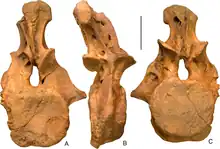 | |
| Holotype vertebra seen from three different angles | |
| Scientific classification | |
| Domain: | Eukaryota |
| Kingdom: | Animalia |
| Phylum: | Chordata |
| Clade: | Dinosauria |
| Clade: | Saurischia |
| Clade: | †Sauropodomorpha |
| Clade: | †Sauropoda |
| Clade: | †Neosauropoda |
| Genus: | †Dzharatitanis Averianov & Sues, 2021 |
| Species: | †D. kingi |
| Binomial name | |
| †Dzharatitanis kingi Averianov & Sues, 2021 | |
Discovery and naming
The holotype was found in 1997 by Hans-Dieter Sues and David J. Ward during the URBAC (Uzbek/Russian/British/American/Canadian) expedition. It was classified as a titanosaur before being given a name on two occasions - firstly by Sues et al. (2015)[3] and then by Averianov and Sues (2017).[4] The genus Dzharatitanis was described in 2021 by Alexander Averianov and Hans-Dieter Sues. It was named after the Dzharakuduk locality in Uzbekistan and the titans in ancient Greek mythology. The genus was based on an anterior caudal vertebra (USNM 538127), likely representing the first caudal, that was originally described as belonging to an intermediate titanosaurian taxon.[1][3] The juvenile dorsal sauropod centrum USNM 538133 may also belong to this taxon.[1]
Classification
The phylogenetic analysis by Averianov and Sues places Dzharatitanis in the Rebbachisauridae, in an unresolved polytomy with Demandasaurus, Nigersaurus, Rayososaurus and Rebbachisaurus. The taxon shares with Demandasaurus and the unnamed rebbachisaur from the Wessex Formation a high spinodiapophyseal lamina on the lateral side of the neural spine, separated from the spinoprezygapophyseal lamina and spinopostzygapophyseal lamina, which may indicate a close relationship between these taxa.[1] However, a study published only a few months later disputed this classification, finding it to be a titanosaur instead, with close affinities to Lognkosauria.[2] The two contrasting results are shown below.
|
Averianov & Sues, 2021[1]
|
Lerzo, Carballido, & Gallina, 2021[2]
|
References
- Averianov, A.; Sues, H.-D. (2021). "First rebbachisaurid sauropod dinosaur from Asia". PLOS ONE. 16 (2): e0246620. doi:10.1371/journal.pone.0246620. PMC 7904184. PMID 33626060.
- Lerzo, Lucas Nicolás; Carballido, José Luis; Gallina, Pablo Ariel (30 April 2021). "¿Saurópodos Rebbaquisáuridos en Asia? Una Re-Evaluación de la Posición Filogenética de Dharatitanis Kingi del Cretácico Tardío de Uzbekistán". Publicación Electrónica de la Asociación Paleontológica Argentina. 21 (1): 18–27. doi:10.5710/PEAPA.24.03.2021.389. ISSN 2469-0228. S2CID 236689007.
- Sues, Hans-Dieter; Averianov, Alexander; Ridgely, Ryan C.; Witmer, Lawrence M. (2015-01-02). "Titanosauria (Dinosauria, Sauropoda) from the Upper Cretaceous (Turonian) Bissekty Formation of Uzbekistan". Journal of Vertebrate Paleontology. 35 (1): e889145. doi:10.1080/02724634.2014.889145. ISSN 0272-4634. S2CID 14598142.
- Averianov, Alexander; Sues, Hans-Dieter (2017). "Review of Cretaceous sauropod dinosaurs from Central Asia". Cretaceous Research. 69: 184–197. doi:10.1016/j.cretres.2016.09.006. ISSN 0195-6671.
